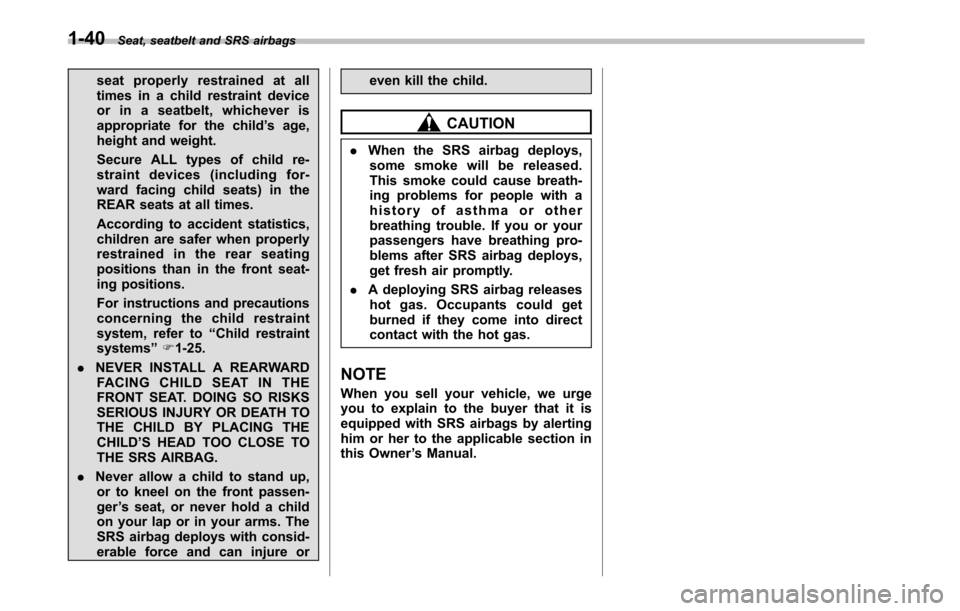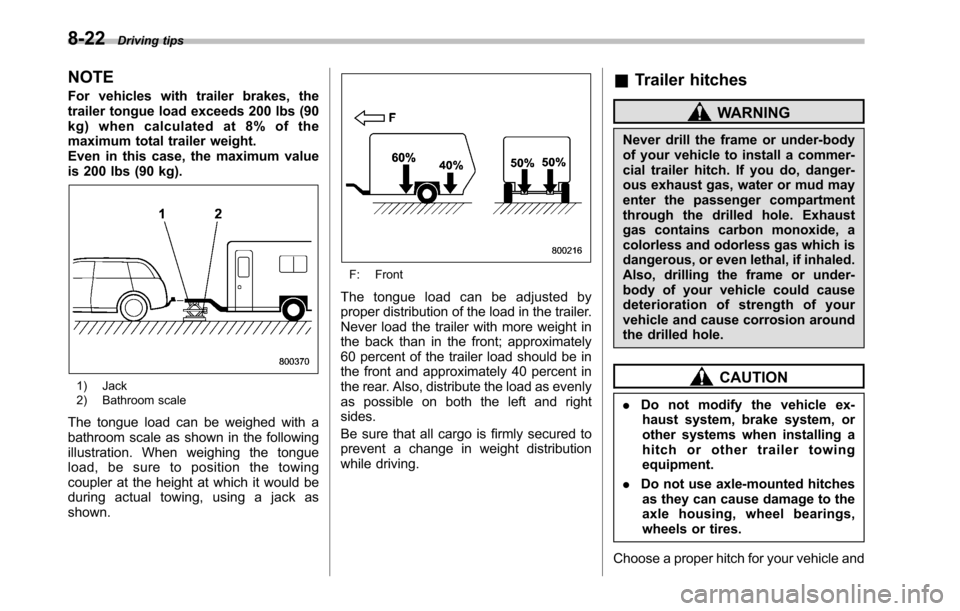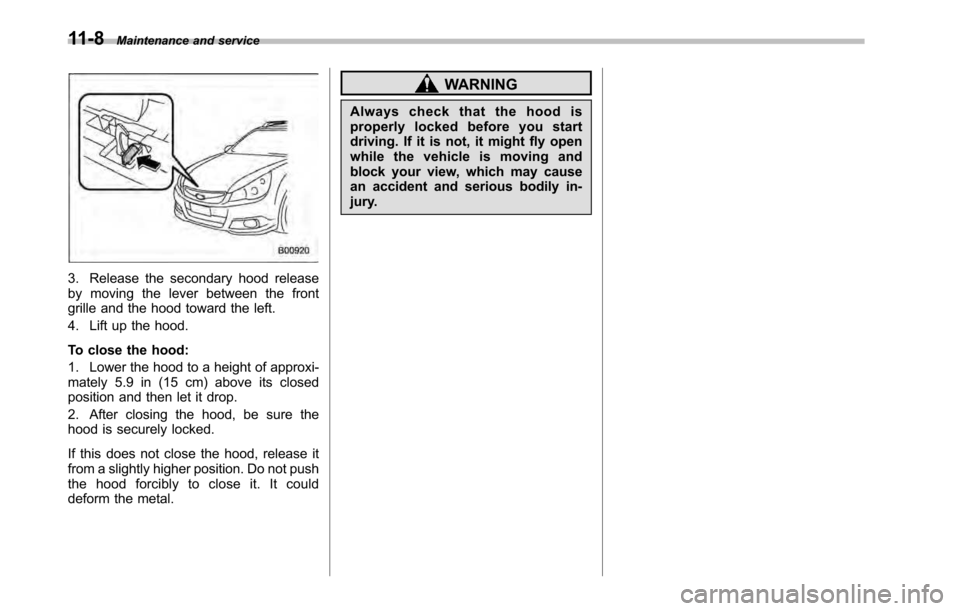2010 SUBARU LEGACY height
[x] Cancel search: heightPage 62 of 448

1-40Seat, seatbelt and SRS airbags
seat properly restrained at all
times in a child restraint device
or in a seatbelt, whichever is
appropriate for the child ’s age,
height and weight.
Secure ALL types of child re-
straint devices (including for-
ward facing child seats) in the
REAR seats at all times.
According to accident statistics,
children are safer when properly
restrained in the rear seating
positions than in the front seat-
ing positions.
For instructions and precautions
concerning the child restraint
system, refer to “Child restraint
systems ”F 1-25.
. NEVER INSTALL A REARWARD
FACING CHILD SEAT IN THE
FRONT SEAT. DOING SO RISKS
SERIOUS INJURY OR DEATH TO
THE CHILD BY PLACING THECHILD ’S HEAD TOO CLOSE TO
THE SRS AIRBAG.
. Never allow a child to stand up,
or to kneel on the front passen-ger ’s seat, or never hold a child
on your lap or in your arms. The
SRS airbag deploys with consid-
erable force and can injure or even kill the child.
CAUTION
. When the SRS airbag deploys,
some smoke will be released.
This smoke could cause breath-
ing problems for people with a
history of asthma or other
breathing trouble. If you or your
passengers have breathing pro-
blems after SRS airbag deploys,
get fresh air promptly.
. A deploying SRS airbag releases
hot gas. Occupants could get
burned if they come into direct
contact with the hot gas.
NOTE
When you sell your vehicle, we urge
you to explain to the buyer that it is
equipped with SRS airbags by alerting
him or her to the applicable section in
this Owner ’s Manual.
Page 306 of 448

8-22Driving tips
NOTE
For vehicles with trailer brakes, the
trailer tongue load exceeds 200 lbs (90
kg) when calculated at 8% of the
maximum total trailer weight.
Even in this case, the maximum value
is 200 lbs (90 kg).
1) Jack
2) Bathroom scale
The tongue load can be weighed with a
bathroom scale as shown in the following
illustration. When weighing the tongue
load, be sure to position the towing
coupler at the height at which it would be
during actual towing, using a jack asshown.
F: Front
The tongue load can be adjusted by
proper distribution of the load in the trailer.
Never load the trailer with more weight in
the back than in the front; approximately
60 percent of the trailer load should be in
the front and approximately 40 percent in
the rear. Also, distribute the load as evenly
as possible on both the left and rightsides.
Be sure that all cargo is firmly secured to
prevent a change in weight distribution
while driving. &
Trailer hitches
WARNING
Never drill the frame or under-body
of your vehicle to install a commer-
cial trailer hitch. If you do, danger-
ous exhaust gas, water or mud may
enter the passenger compartment
through the drilled hole. Exhaust
gas contains carbon monoxide, a
colorless and odorless gas which is
dangerous, or even lethal, if inhaled.
Also, drilling the frame or under-
body of your vehicle could cause
deterioration of strength of your
vehicle and cause corrosion around
the drilled hole.
CAUTION
. Do not modify the vehicle ex-
haust system, brake system, or
other systems when installing a
hitch or other trailer towingequipment.
. Do not use axle-mounted hitches
as they can cause damage to the
axle housing, wheel bearings,
wheels or tires.
Choose a proper hitch for your vehicle and
Page 344 of 448

11-8Maintenance and service
3. Release the secondary hood release
by moving the lever between the front
grille and the hood toward the left.
4. Lift up the hood.
To close the hood:
1. Lower the hood to a height of approxi-
mately 5.9 in (15 cm) above its closed
position and then let it drop.
2. After closing the hood, be sure the
hood is securely locked.
If this does not close the hood, release it
from a slightly higher position. Do not push
the hood forcibly to close it. It could
deform the metal.
WARNING
Always check that the hood is
properly locked before you start
driving. If it is not, it might fly open
while the vehicle is moving and
block your view, which may cause
an accident and serious bodily in-
jury.
Page 368 of 448

11-32Maintenance and service
Use only clutch fluid from a sealed
container. &Recommended clutch fluid
FMVSS No. 116, fresh DOT 3 or 4 brake fluid
CAUTION
Avoid mixing DOT 3 and DOT 4
brake fluids even if they are of the
same brand. Brake booster
If the brake booster does not operate as
described in the following procedure, have
it checked by your SUBARU dealer.
1. With the engine off, depress the brake
pedal several times, applying the same
pedal force each time. The distance the
pedal travels should not vary.
2. With the brake pedal depressed, start
the engine. The pedal should move
slightly down to the floor.
3. With the brake pedal depressed, stop
the engine and keep the pedal depressed
for 30 seconds. The pedal height should
not change.
4. Start the engine again and run for
approximately 1 minute then turn it off.
Depress the brake pedal several times to
check the brake booster. The brake
booster operates properly if the pedal
stroke decreases with each depression. NOTE
When you depress the brake pedal
strongly or suddenly, the following
phenomena occur. However, even
though these occur, they do not indi-
cate any malfunctions, and the brake
assist system is operating properly. .
You might feel that the brake pedal is applied by lighter force and gener-
ates a greater braking force..
You might hear the sound of ABS
operating from the engine compart-ment.
Brake assist is not a system that brings
more braking ability to the vehicle
beyond its breaking capability.
Page 398 of 448

12-2Specifications
Specifications
These specifications are subject to change without notice. &Dimensions
in (mm)
Item Legacy
Outback
2.5 L non-turbo 2.5 L turbo 3.6 L 2.5 L non-turbo
3.6 L
Drive system AWD
Transmission type MT CVT MT AT MT CVT AT
Overall length 186.4 (4,735) 188.2 (4,780)
Overall width 71.7 (1,820) 71.7 (1,820)
Overall height 59.3 (1,505) 66.1 (1,680)
*2
65.7 (1,670)*3
Wheelbase
108.3 (2,750) 107.9 (2,740)
Tread Front 61.6 (1,565) 61.0 (1,550) 61.6 (1,565) 61.0 (1,550)
Rear 61.8 (1,570) 61.2 (1,555) 61.8 (1,570) 61.0 (1,550)
Ground clearance
*15.9 (150) 8.7 (220)
*1: Measured with vehicle empty
*2: Measured when roof rails are used as crossbars
*3: Measured when roof rails are not used as crossbars
AT: Automatic transmission
MT: Manual transmission
CVT: Continuously variable transmission
AWD: All-Wheel Drive
Page 412 of 448

13-2Consumer information and Reporting safety defects
For U.S.A.
The following information has been
compiled according to Code of
Federal Regulations “Title 49, Part
575 ”. Tire information &
Tire labeling
Many markings (e.g. Tire size, Tire
Identification Number or TIN) are
placed on the sidewall of a tire by
tire manufacturers. These marking
can provide you with useful infor-
mation on the tire. ! Tire size
Your vehicle comes equipped with
P-Metric tire size. It is important to
understand the sizing system in
selecting the proper tire for your
vehicles. Here is a brief review of
the tire sizing system with a break-
down of its individual elements. ! P Metric
With the P-Metric system, Section
Width is measured in millimeters.
To convert millimeters into inches,
divide by 25.4. The Aspect Ratio
(Section Height divided by Section
Width) helps provide more dimen-
sional information about the tiresize. Example:
(1) P = Certain tire type used on
light duty vehicles such as passen-
ger cars
(2) Section Width in millimeters
(3) Aspect Ratio (= section height 7
section width).
(4) R = Radial Construction
(5) Rim diameter in inches ! Load and Speed Rating Descrip- tions
The load and speed rating descrip-
tions will appear following the size designation.
They provide two important facts
about the tire. First, the number
designation is its load index. Sec-
ond, the letter designation indicates
the tire ’s speed rating.
Page 433 of 448

Electrical system........................................................ 12-3
Electronic Brake Force Distribution (EBD) system ........................................................... 3-18, 7-26
Electronic parking brake. ............................................. 7-34
Automatic release function by gas pedal ................... 7-35
Hill Holder ............................................................. 7-35
Warning ........................................................ 3-19, 7-37
Emergency Locking Retractor (ELR) ............................. 1-13
Engine
Compartment overview ........................................... 11-9
Coolant ................................................................ 11-18
Exhaust gas (carbon monoxide) ............................. 6, 8-2
Hood .................................................................... 11-7
Low oil level warning light ....................................... 3-14
Oil....................................................................... 11-12 Overheating .......................................................... 9-12
Starting ................................................................... 7-8
Stopping ............................................................... 7-10
Exterior care .............................................................. 10-2
F
Flat tires ..................................................................... 9-6
Floor mat .................................................................. 6-14
Fluid level
Automatic transmission .......................................... 11-24
Brake .................................................................. 11-30
Clutch .................................................................. 11-31
Power steering ..................................................... 11-29
Fog light Bulb .................................................................... 11-53
Indicator light ......................................................... 3-23 Switch
................................................................... 3-30
Front Differential gear oil ................................................ 11-26
Fog light ...................................................... 3-30, 11-53
Fog light indicator light ............................................ 3-23
Position light ........................................................ 11-53
Seatbelt pretensioners ............................................ 1-22
Turn signal light .................................................... 11-53
Front seats ................................................................. 1-2
Forward and backward adjustment ............................ 1-3
Power seat ............................................................. 1-4
Reclining ................................................................ 1-3
Seat height adjustment (driver ’s seat) ........................ 1-4
Fuel ........................................................................... 7-2
Economy hints ........................................................ 8-2
Filler lid and cap ...................................................... 7-3
Gauge .................................................................... 3-7
Requirements ......................................................... 7-2
Fuses ..................................................................... 11-48
Main fuse ............................................................ 11-50
Fuses and circuits ...................................................... 12-6
G
GAWR (Gross Axle Weight Rating) .. ............................. 8-13
Glove box ................................................................... 6-6
GVWR (Gross Vehicle Weight Rating) ........................... 8-13
H
Hands-free system. ..................................................... 5-32
Hazard warning flasher .......................................... 3-5, 9-2
Head restraint adjustment Index
14-5
Page 437 of 448

Headlight............................................................. 11-50
License plate light ................................................. 11-57
Map light .............................................................. 11-59
Rear combination light ........................................... 11-54
Tail and rear side marker light (Outback) .................. 11-55
Tail/Back-up light (Outback) .................................... 11-56
Trunk light ............................................................ 11-60
Vanity mirror light .................................................. 11-59
Rocking the vehicle .................................................... 8-11
Roof rails with integrated cross bars ............................. 8-14
S Safety Precautions when driving ............................................. 4
Symbol ...................................................................... 2
Warnings ................................................................... 2
Seat
Fabric ................................................................... 10-5
Front ...................................................................... 1-2
Heater .................................................................... 1-6
Height adjustment .................................................... 1-4
Rear ....................................................................... 1-7
Seatbelt ................................................................. 4, 1-12
Fastening .............................................................. 1-15
Maintenance .......................................................... 1-22
Pretensioners ........................................................ 1-22
Safety tips ............................................................. 1-12
Warning light and chime ................................. 1-14, 3-10
Security Alarm system ........................................................ 2-16
ID plate ................................................................... 2-3 Immobilizer
............................................................. 2-3
Indicator light .................................................. 2-4, 3-22
Shock sensors ....................................................... 2-19
Select lever ............................................................... 7-19
Position indicator .................................................... 3-22
Shift lock function ................................................... 7-20
Shock sensors ........................................................... 2-19
Shopping bag hook ..................................................... 6-14
Snow tires ....................................................... 8-10, 11-35
Snowy and icy roads ................................................... 8-9
Sounding a panic alarm .............................................. 2-10
Spark plugs ............................................................. 11-22
Specifications ............................................................. 12-2
Speedometer .............................................................. 3-6
SRS Curtain airbag ........................................................ 1-53
Frontal airbag ......................................................... 1-43
Side airbag ............................................................ 1-53
SRS airbag (Supplemental Restraint System airbag)... 4, 1-38
SRS airbag system Monitors ................................................................ 1-62
Servicing ............................................................... 1-63
Warning light .......................................................... 3-11
Starting the engine ...................................................... 7-8
State emission testing (U.S. only) .................................. 7-6
Steering wheel Power ................................................................... 7-23
Tilt/telescopic ......................................................... 3-38
Stopping the engine .................................................... 7-10
Storage compartment ................................................... 6-5
Sun shade ................................................................. 2-30 Index
14-9